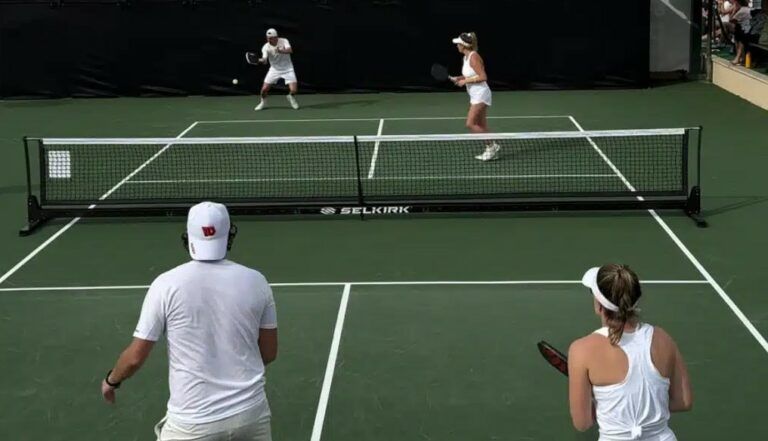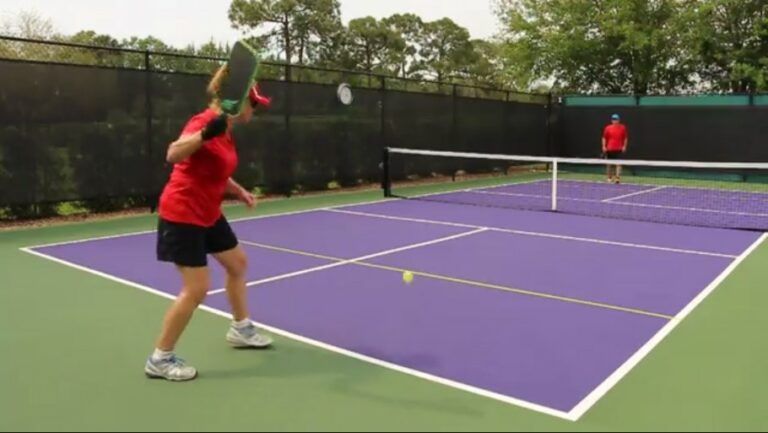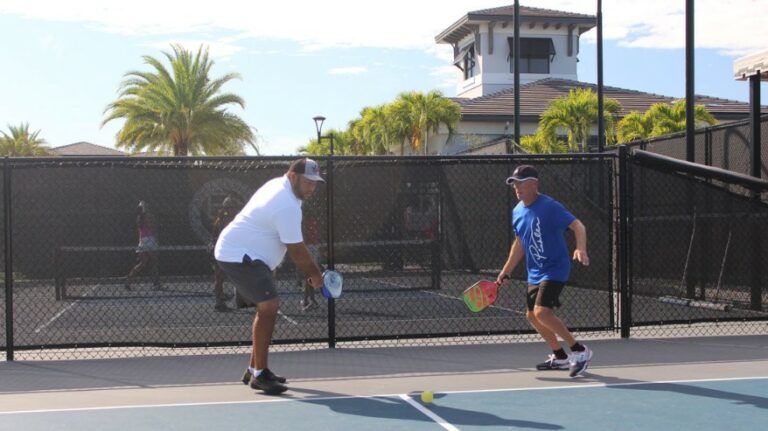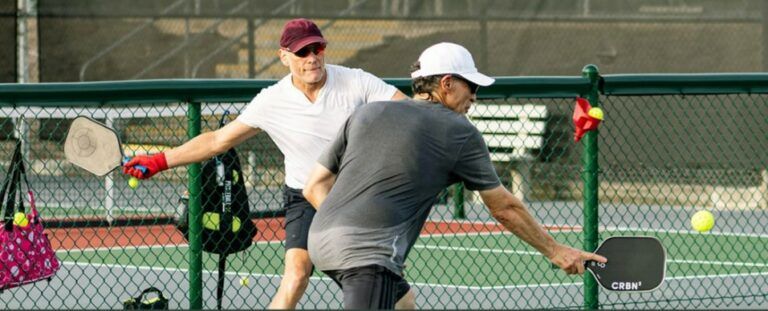Why the Pickleball return of serve matters
The significance of a well-executed return of serve cannot be overstated. This pivotal aspect of pickleball provides a strategic advantage for the returning team, as it can seamlessly transition from defense into an assertive offensive play. Returning a serve isn't just a reaction to the ball being hit at you; it offers the opportunity to dictate the pace and tone of the rally. By effectively returning the serve, players can pressure their opponents and take control of the net, also known as the kitchen, which is essential for capitalizing on scoring opportunities.
The returning team's position in the rally is critical. A strong return can disrupt the server's rhythm, forcing them into making hasty decisions about their next shot. Imagine a chess match where every move counts this is exactly how a good return works to your advantage. The psychological impact is significant; a successful return builds confidence and can create doubt in the opponent's mind, altering their focus and strategies in the subsequent points.

The strategic advantage: Turn defense into offense
To turn defense into offense during pickleball, the return of serve acts as the first strike. An effective return pushes the server back into their court, making it more challenging for them to execute their next shot. This strategic shift empowers the returner to assume a more dominant position in the game. Placing the return deep into the opponent's court specifically limits their options and gives you time to prepare for what comes next.
Additionally, targeting a weaker opponent during mixed doubles or team scenarios enhances the chances of capitalizing on their vulnerabilities. By exploiting weaknesses with precision, players can create opportunities that quickly shift the momentum in their favor. The importance of gaining control of the net cannot be understated being the first player to step forward often secures winning plays and rallies.
Building a solid foundation: Technique and positioning
Achieving an effective return of serve requires a strong foundation built on appropriate technique and positioning. Having a consistent, reliable stance is critical, as every successful return starts with how you position yourself before the serve even arrives.
Finding your stance: Ready to react
Your starting position should be about seven feet behind the baseline. This distance allows for ample reaction time, giving you the chance to respond effectively to various types of serves. To enhance your readiness, incorporate the "split step" technique. As the server prepares to make their move, take a small hop to set your weight evenly on both feet. This action primes your body for instant movement, helping you pivot efficiently as the ball approaches.

Once the ball is in play, aim to move forward to meet it rather than waiting for it to come to you. This mindset helps you generate forward momentum, creating a more powerful return. Mastering this combination of stance and movement elevates your overall performance significantly, ensuring you're always one step ahead of the competition.
Grip and paddle control: A relaxed approach
Equally important is understanding your grip and paddle control. Using a relaxed grip allows you to absorb the serve's power, converting it into a controlled return. Aim for a grip style that suits your playstyle, such as the Continental grip, which offers the flexibility needed for different shots. Keep in mind that striking the ball at its sweet spot is critical for consistency and reliability.
When you maintain a relaxed approach, it reduces the likelihood of mishits. Engaging your larger muscle groups for power not just relying on wrist movement ensures that your return is both robust and accurately placed.
Executing the return: Tips and strategies
Transitioning from understanding your stance and grip to executing the return is where practice meets performance. Learning to effectively return serves relies heavily on grasping some fundamental strategies that can maximize your effectiveness on the court.

The power of depth: Keeping your opponents back
One of the most crucial strategies in executing a return is the power of depth. A deep return for instance, aiming for the back third of the service box puts immediate pressure on your opponent. It forces them to position themselves further behind, creating an opportunity for you to take control of the point.
To generate depth, focus on using your lower body and core to provide the necessary strength while maintaining control a genuine demonstration of strength in technique, if you will. Engaging these muscle groups enhances your power without sacrificing accuracy, creating a dynamic return that challenges even seasoned players.
Utilizing height: The high return advantage
Understanding the benefits of returning the ball with height alters the game narrative. High returns give you more time to reach the net, facilitating a seamless transition from defense to offense. While high returns are a useful tactic, they should not be confused with lobs. Instead, mastering the arc and depth of high returns enables you to control how difficult your opponents find their next shot.
When returning serves, aim for a high trajectory to ensure that the ball crosses the net at an advantageous angle. This practice isn’t merely about safety; high returns can complicate your opponent's rhythm, leading to mistakes that turn the tide in your favor.
Handling different serve types and game situations
Returning serves isn’t a one-size-fits-all strategy. Adapting to varying serve types and recognizing game situations are vital components of effective play.

Deciphering the serve: Recognizing types and strategies
Being able to recognize different serve types, such as flat, topspin, and slice serves, forms the foundation for making informed decisions during play. Each type of serve has its unique trajectory and behavior that can affect how you should approach your return.
For example, flat serves tend to come at you with speed, demanding a quick reaction time, whereas slice serves may redirect toward your body, necessitating adjustments in footwork. Observing the server's motion can provide clues about the type of serve they'll deliver, allowing you to adjust your positioning accordingly. This proactive approach increases the likelihood of a successful return.
Adapting to the game: Situational return strategies
When playing doubles, concepts such as "stacking" and "switching" can introduce additional layers of strategy involving returns. Being agile in your tactics based on court positions and adapting your return strategy can greatly influence the match's outcome. Reading the opponent's playing style, recognizing their strengths and weaknesses, and shifting your return strategy accordingly are essential for success.
Moreover, having a keen understanding of the court's layout allows you to implement tailored returns that capitalize on your opponents' tendencies. Implementing situational awareness in your returns can turn the course of matches, leading to unexpected victories.
Taming the power serve: Tips for beginners
Facing powerful serves can be daunting for beginners, but with the right techniques, players can build confidence and maintain control.
Paddle ready: The foundation of control
For those grappling with powerful serves, beginning with an optimal paddle-ready position is crucial. Position your paddle in a stable, yet relaxed, posture that allows for responsiveness without tension. A firm grip helps you maintain control without exerting excess force, increasing your chances of successful returns.
Blocking vs. swinging: Absorb and redirect
Understanding when to block versus when to swing at power serves is essential for beginners. Blocking involves absorbing the serve's power by maintaining your paddle's position, redirecting the ball back without overexerting. On the other hand, when you identify a serve that allows you to take a controlled swing, consider shifting your weight into it for a more powerful return.
Maintaining control while minimizing the risk of overhitting will bolster your self-confidence, allowing you to handle powerful serves with grace.
The mental game: Overcoming fear and building confidence
While physical skill is crucial, the mental aspect of returning serves, especially against powerful opponents, is equally important.
Conquering serve anxiety: Staying calm under pressure
Many players experience anxiety when facing powerful servers, often paralyzing their performance. Recognizing these emotions and implementing relaxation techniques, such as deep breathing and positive visualization, can help overcome this fear.
Visualize successfully returning the serve; create a mental image where you execute the return perfectly. These mental practices can prepare you for the actual game experience, instilling confidence and reducing the anxiety associated with powerful serves.
Building confidence: The power of practice and positivity
Consistent practice is key to developing muscle memory, which translates to instinctive responses during matches. Emphasizing a growth mindset allows players to view challenges as opportunities for improvement rather than setbacks. Celebrate small victories, whether mastering a technique or executing a successful return, to cultivate a positive atmosphere around your game.
Setting achievable goals helps track progress and maintain motivation, reinforcing a cycle of improvement and increasing confidence steadily.
Mastering the transition: From return to net dominance
The transition from return to effectively dominating the net can drastically influence match outcomes.
The quick transition: Using momentum to your advantage
After executing a successful return, moving quickly to the non-volley zone (NVZ) is paramount. Utilizing the momentum created by your return enhances your likelihood of maintaining control at the net.
Practice moving toward the NVZ line immediately after making your return to create a seamless play style that places added pressure on your opponents.
Drills to sharpen your skills: Practice makes perfect
Incorporating specific drills designed to improve your return-to-net transitions can lead to significant progress over time. For instance, partner drills focusing on returning serves and immediately transitioning to the NVZ can help instill the necessary skills for swift movements.
Varying practice routines keeps training engaging and less monotonous, improving your overall skill set while preparing you for an array of match situations.
Troubleshooting common mistakes: Turning errors into opportunities
Recognizing and addressing common errors in returning serves can lead to improved performance overall.
Short returns: Identifying the culprits and finding solutions
Short returns often stem from a lack of follow-through, improper positioning, or hitting the ball off-center. To combat these issues, focusing on follow-through mechanics is critical. Experiment with drills that target follow-through, emphasizing making contact with the ball in your optimal striking zone.
Long returns: Taming the overhit and finding control
On the opposite end, long returns can be attributed to excessive backswing or relying too heavily on arm strength. Adjusting your swing technique to simplify motion and focus on engaging your whole body will enhance control. Consistent practice with attention to form can alleviate issues surrounding overhitting.
Spin control: Simplifying technique and embracing practice
Practice spinning techniques in manageable steps can help players gain confidence while simplifying their technique. Utilizing drills where you focus on generating consistent spin without losing control can improve your return quality significantly.
Conclusion: Elevate your game with a confident return
Ultimately, the return of serve in pickleball is an essential component that warrants dedicated practice and strategic thought. By mastering the techniques and strategies discussed, you not only bolster your individual performance but also positively influence your team's success on the court. Remember, every serve is an opportunity; approach it with confidence and dedication. Don’t hesitate to seek guidance from experienced players or coaches who can provide personalized insights. Embrace the process of mastering the return of serve, and remember to enjoy the game it’s all about growing, learning, and building lasting connections along the way.










